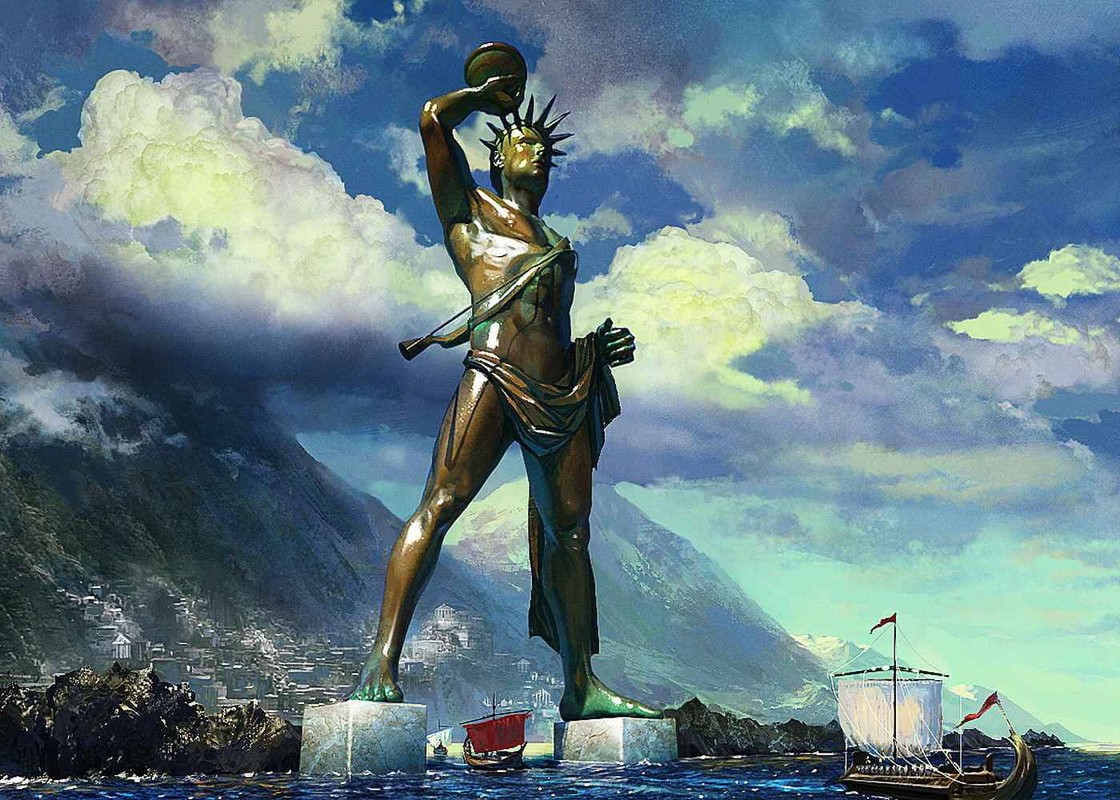The Colossus of Rhodes, an iconic ancient statue, was one of the Seven Wonders of the Ancient World. Erected between 280 and 280 BCE, this colossal bronze statue stood approximately 33 meters (108 feet) high and depicted the sun god Helios. Constructed to celebrate the successful defense of Rhodes against a siege by Demetrius I, the statue was situated at the entrance of the harbor of the city of Rhodes, serving both as a monumental symbol of victory and a navigational landmark for incoming ships. Its immense scale and intricate construction made it one of the most impressive achievements of ancient engineering and artistry, reflecting the grandeur of Hellenistic sculpture and the significance of Helios in Rhodian culture.
Construction and Design
The construction of the Colossus of Rhodes was a monumental engineering feat, undertaken by the sculptor Chares of Lindos. The statue was made of bronze plates over a core of iron and stone, with an internal framework that allowed it to stand upright. The design depicted Helios with a crown of rays, symbolizing his association with the sun. The statue’s base was constructed on a large pedestal, which elevated the figure above the harbor entrance. The use of bronze and the complex assembly of the statue’s parts showcased the advanced metallurgical techniques and artistic skills of the time.

Historical Context
The Colossus was created during a period of significant political and military events in the Hellenistic world. The statue was commissioned to commemorate Rhodes’ victory over the Macedonian king Demetrius I Poliorcetes, who had besieged the city in 305 BCE. The successful defense and subsequent construction of the Colossus symbolized the resilience and strength of the Rhodian people. The statue was not only a testament to their military success but also an expression of their devotion to Helios, the patron deity of the island.
Artistic Significance
The Colossus of Rhodes was a masterpiece of ancient sculpture, representing a high point in Hellenistic art. The statue’s scale and detail exemplified the technical and artistic capabilities of the period. Its pose, with one arm outstretched and the other holding a torch, created a dramatic and imposing presence. The artistic execution of the Colossus demonstrated the ability of ancient Greek sculptors to convey both grandeur and dynamism in their work. The statue’s design and execution influenced subsequent monumental sculptures and continued to be admired for its artistic achievements.
Structural Challenges
The construction of the Colossus posed several structural challenges due to its immense size and weight. The statue’s design required a strong and stable foundation to support its height and prevent collapse. The core structure was built using large blocks of stone, with bronze plates attached to create the outer surface. The internal framework was designed to distribute the weight evenly and maintain the statue’s stability. Despite the innovative engineering solutions employed, the Colossus faced challenges related to its scale, which ultimately contributed to its eventual collapse.
Collapse and Aftermath
The Colossus of Rhodes was destroyed by an earthquake in 226 BCE, just 56 years after its completion. The statue’s base and remains were left in a fallen state, creating a lasting impression on those who saw it. The remnants of the statue became a tourist attraction and a symbol of both the grandeur and fragility of human achievements. Despite its destruction, the Colossus continued to be celebrated in ancient literature and art, serving as a symbol of the Rhodian people’s resilience and the artistic achievements of their era.
Vote
Who is your all-time favorite president?
Influence and Legacy
The Colossus of Rhodes has had a lasting influence on art and architecture throughout history. Its scale and design set a precedent for monumental statues and inspired subsequent works of art and engineering. The image of the Colossus has been referenced in various cultural and artistic contexts, symbolizing both the grandeur of ancient civilization and the challenges of constructing large-scale monuments. The legacy of the Colossus continues to be recognized as a testament to the artistic and engineering prowess of the ancient Greeks.
Modern Reconstructions
Modern reconstructions and artistic depictions of the Colossus of Rhodes are based on ancient descriptions, historical accounts, and archaeological findings. Scholars and artists have created various models and visualizations to represent the statue’s original appearance and scale. These reconstructions help to illustrate the grandeur of the Colossus and provide insights into its historical and artistic significance. While the physical statue no longer exists, these modern interpretations preserve the memory and impact of this remarkable ancient wonder.
Archaeological Research
Archaeological research at the site of the Colossus of Rhodes has focused on studying the remains and historical records related to the statue. Excavations have uncovered evidence of the statue’s base and structural components, providing insights into its construction and design. Research has also involved analyzing ancient texts and accounts to reconstruct the appearance and significance of the Colossus. Ongoing archaeological efforts contribute to the understanding of the statue’s history and its role in ancient Rhodian society.
Cultural References
The Colossus of Rhodes has been referenced and celebrated in various cultural contexts, from literature and art to modern media. Its image and legacy have appeared in works ranging from classical literature to contemporary films and artworks. The statue’s enduring symbol of strength and grandeur continues to capture the imagination of people around the world. Its representation in cultural references highlights the continued fascination with ancient wonders and their impact on artistic and cultural expressions.
Summary
The Colossus of Rhodes stands as a testament to the artistic and engineering achievements of the ancient world. As one of the Seven Wonders of the Ancient World, it represents the grandeur and innovation of Hellenistic sculpture and architecture. Despite its destruction, the legacy of the Colossus endures through historical accounts, modern reconstructions, and cultural references. The statue’s influence on art, architecture, and cultural imagination reflects its enduring significance as a symbol of ancient excellence and human ambition.